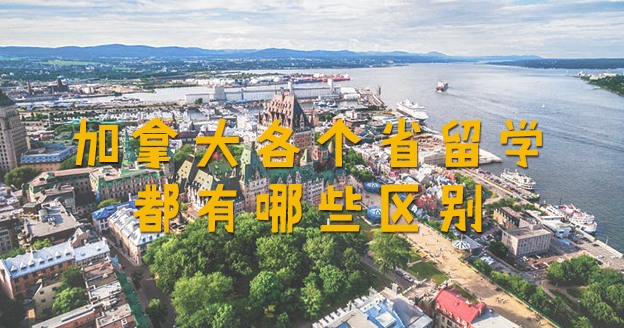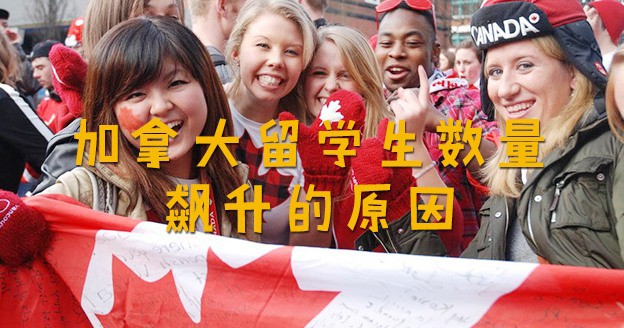With a combination of the great natural environment and exceptional cities welcoming international students, Canada has become one of the top study-abroad destinations in the world. Canada welcomes approximately 16 million tourists each year, and currently more than 300,000 international students are studying here. Those who enjoy winter sports and other outdoor activities will love it here. In addition, Canada’s trendy nightlife, cultural and sports activities also prove that it is a vibrant place to live in and explore. You will never be bored when studying here.
Montreal
QS Best Student Cities 2016: 7th
In the QS ranking of the Best Student Cities 2016, Montreal is ranked the top city in Canada. Most people think that Montreal is Canada's "cultural hub." It is, in fact, famous for its cuisine and concerts, with a mixture of French and English influences. In addition, there are various international festivals held there every year. In the 2015 QS Best Student Cities rankings, Montreal ranked 8th overall, and received a high score in the category of "student mix," which also reflects Montreal's huge and internationally diverse student community. The highest ranked university in Montreal isMcGill University, currently ranked 24th in the world, followed by the University of Montreal (in the top 100 in the world) and Concordia University (in the top 500 in the world).
Montreal is the largest city in Quebec, the second largest city in Canada and the fifteenth largest city in North America. It is also the second largest French-speaking city in the world after Paris. Montreal was once the economic capital of Canada, with the largest population and the most developed economy, but was surpassed by Toronto, Ontario in 1976. Today Montreal is still one of Canada’s most important economic centres, with developed industries such as aviation, finance, design, film, and so on. Montreal is considered to be the best livable city in the world and has been recognized as an eclectic city by the United Nations Educational, Scientific and Cultural Organization.
Montreal was once the economic capital of Canada, with the largest population and the most developed economy, but was surpassed by Toronto, Ontario in 1976. Today Montreal is still one of Canada’s most important economic centres, with developed industries such as aviation, finance, design, film, and so on. Montreal is considered to be the best livable city in the world and has been recognized as an eclectic city by the United Nations Educational, Scientific and Cultural Organization.
Several of Canada’s highest ranked universities are located in Montreal, including McGill University (currently ranked 24th in the world and Canada’s 1st). Montreal is known as Canada's cultural hub and is also one of the most livable cities in the world. In the 2016 QS Best Student Cities ranking, Montreal continued to maintain the status of the world's best destination for international students, rising from the previous 8th to 7th place, after Singapore.
As a French-speaking city in most English-speaking countries, Montreal has experienced large-scale immigration from all over the world in the past few decades, so Montreal has a clear mixed culture. The city has a world-renowned independent music scene, and is also home to several major international festivals, including the Montreal International Jazz Festival and the world ’s largest comedy festival, "Just for Laughs Comedy Festival."
With a relatively large and diverse student population, Montreal received its highest score in the “Student Mix” category of the QS Best Student Cities rankings. Montreal's biggest disadvantage is affordability, but compared to other cities that entered the top 10, Montreal is not the highest at this point.
| Number of universities in the QS World University Rankings | 3 |
| Ranked first among all universities | McGill University (ranked 24th in the world) |
| Population | 3,820,000 |
| Number of students (% of total population) | 2.6% (calculated based on the number of students |
| Percentage of international students | 27.0% (calculated based on the number of students entering the ranked universities) |
| Average tuition fee amount | $13,500 USD |
| The Global Livability Index | Ranked 14th (total of 140 cities) |
| Mercer Cost of Living Survey Rankings | — |
| Price of a Big Mac | $4.54 USD |
| Price of an iPad | $467.15 USD |
| NumbeoSecurity Rankings | 157th (total 446 cities) |
| NumbeoPopulation Rankings | 223rd (300 cities in total) |
| Transparency International Rankings | 9th (out of 177 cities) |
Toronto
2016 QS Best Student Cities Rankings: Tied for 13th
In the 2015 QS Best Student Cities Rankings, Toronto is only one place behind Montreal and is ranked 9th overall. Montreal and Toronto are strong competitors in various indicators. Toronto also has a variety of exciting cultures, food and nightlife, as well as a booming higher education. In fact, the University of Toronto is ranked one place higher than McGill University in the QS World University Rankings and also joins the International Alliance initiated by York University and Ryerson University. Toronto beat all cities in terms of "Desirability" and got the highest score, which also reflects the quality of life in Toronto, but in the other four categories, Toronto falls under Montreal. Toronto is the largest city in Canada, ranked by population in North America, and is the fourth largest city after Mexico City, New York and Los Angeles. Toronto is one of the most diverse cities in the world. 49% of the residents are immigrants from more than 100 ethnic groups from all over the world. People of 140 languages are gathered in this North American metropolis. Due to the extremely low crime rate and pleasant environment, Toronto is rated as one of the most livable cities in the world, and its ranking has occupied the top ten livable cities in the world for many consecutive years.
Toronto is the largest city in Canada, ranked by population in North America, and is the fourth largest city after Mexico City, New York and Los Angeles. Toronto is one of the most diverse cities in the world. 49% of the residents are immigrants from more than 100 ethnic groups from all over the world. People of 140 languages are gathered in this North American metropolis. Due to the extremely low crime rate and pleasant environment, Toronto is rated as one of the most livable cities in the world, and its ranking has occupied the top ten livable cities in the world for many consecutive years.
Toronto is the largest city in Canada that combines all the best the country can offer, including diverse communities, vibrant culture and nightlife, stunning natural surroundings, and of course, world-class universities.
Montreal, another competing Canadian city, retains a slight lead. Montreal was ranked six places higher than Toronto in the 2016 QS Best Student Cities Rankings. These two cities are also close competitors in terms of university rankings. Both cities are strong contenders for the title of "Cultural Hub" in Canada. Toronto has a thriving art, fashion, and creative community, plus a wide range of international cuisines. Also, Toronto received the highest overall score in the "Desirability" category of the QS Best Student Cities Rankings and ranked fourth in a total of 140 cities in the Global Livability Index of the Economist.
| Number of universities in the QS World University Rankings | 3 |
| Ranked first among all universities | University of Toronto (ranked 34th in the world) |
| Population | 5,580,000 |
| Number of students (% of total population) | 2.6% (calculated based on the number of students |
| Percentage of international students | 17.0% (calculated based on the number of students entering the ranked universities) |
| Average tuition fee amount | $23,400 USD |
| The Global Livability Index | 4th (140 cities in total) |
| Mercer Cost of Living Survey Rankings | 126th (total 214 cities) |
| Price of a Big Mac | $4.54 USD |
| Price of an iPad | $467.15 USD |
| NumbeoSecurity Rankings | 110th (total 446 cities) |
| NumbeoPopulation Rankings | 186th (300 cities in total) |
| Transparency International Rankings | 9th (out of 177 cities) |
Vancouver
2016 QS Best Student Cities Rankings: Tied for 13th
On the west coast of Canada, Vancouver is another very popular destination for studying abroad. Vancouver has an incomparable combination of ocean scenery, winter sports and urban life. Vancouver’s top university is the University of British Columbia, easily entering the world’s top 50, and the nearby Simon Fraser University offers the opportunity to study in the core area of the Burnaby Mountain Reserve. The highest score for Vancouver is in the "Desirability" category, which is not surprising. At the same time, Vancouver also received the same high score in "Student Mix", which reflects that a large number of international students have been attracted by the prosperous Vancouver’s beautiful natural scenery.
Vancouver has a mild climate throughout four pleasant seasons. The city’s grasslands are evergreen and blooming. Vancouver's film production industry is developed, and it is the third largest in North America after Los Angeles and New York. It is known as Hollywood North.
There are nearly 400,000 Chinese in the Greater Vancouver area, and its Chinese community is also one of the largest Chinese communities in North America. Vancouver is a place where many Asians live. It is a beautiful city that harmoniously brings together modern urban civilization and natural beauty, enchanting countless people who have been there. There are many large parks, modern buildings, charming lake trails, and well-preserved historical buildings. Its residents consist of many immigrants from all over the world, no matter what ethnicity, no one in the local area thinks you are a foreigner. So, the first impression tourists have of Vancouver is that the people are kind and accommodating.
Although Vancouver is sometimes overshadowed by its follow Canadian cities, Montreal and Toronto, Vancouver cannot be overlooked. In the 2015 QS Best Student Cities Rankings, Vancouver continued to maintain its position in the top 15 in the world, and tied for 13th place with Toronto and Boston, USA.
Two universities in Vancouver entered the 2015-2016 QS World University Rankings. The highest ranked Canadian university is the University of British Columbia, ranking 50th in the world. Vancouver's other ranked university, Simon Fraser University, offers specialty courses, because its main campus is in the Burnaby Mountain Reserve outside the city.
Whether you are in the city or not, Vancouver can provide you with a lot of things. The nearby Grouse Mountain, Mount Seymour and Cypress Mountain provide not only the beautiful scenery of the city; they are also very popular winter sports locations. Vancouver has one of the best ski resorts in the world.
Even in downtown Vancouver, the outdoors is never far away. Beaches, forests, and charming mountains are easily accessible. For those who are into culture, Vancouver also has a wide range of nightlife, theatre and music – plus all that you expect from one of Canada's most popular cities.
Universities ranked in QS World University Rankings
University of British Columbia; Simon Fraser University
More about Vancouver
| Number of universities in the QS World University Rankings | 2 |
| Ranked first among all universities | University of British Columbia (ranked 50th in the world) |
| Population | 2,310,000 |
| Number of students (% of total population) | 3.2% (calculated based on the number of students entering the ranked universities) |
| Percentage of international students | 23.0% (calculated based on the number of students entering the ranked university) |
| Average tuition fee amount | $19,100 USD |
| The Global Livability Index | 3rd (140 cities in total) |
| Mercer Cost of Living Survey Rankings | 119th (total 214 cities) |
| Price of a Big Mac | $4.54 USD |
| Price of an iPad | $467.15 USD |
| NumbeoSecurity Rankings | 160th (total 446 cities) |
| NumbeoPopulation Rankings | 270th (300 cities in total) |
| Transparency International Rankings | 9th (out of 177 cities) |
Ottawa
2016 QS Best Student Cities: Ranked 49th along with Mexico City and San Diego
Today, Ottawa has become the political and industrial technology centre of Canada, and is also a large city with a multicultural, high standard of living and low unemployment. The University of Ottawa, founded in 1848, is the oldest and largest bilingual English-French university in North America. As a comprehensive, research-oriented, world-class university, it offers a variety of bilingual courses for more than 36,000 students from different countries on the five continents. The 10 colleges of its universities offer different degrees and majors, including management, art, education, engineering, health sciences, law, medicine, science and social sciences. Because of its central location in the Canadian capital, students at the University of Ottawa can not only enjoy the university’s comprehensive campus facilities, but also easily benefit from the services of federal government departments, institutions, laboratories and libraries. Students can also obtain resources from the international community through the foreign embassies and high commissioners established here. The most prominent natural science and social science research institutions are the National Institute of Natural Sciences of Canada and the North American Society of Canada, both of which are located in Ottawa, where the most influential natural scientists and sociologists in the country are concentrated. A large number of academic achievements come out every year. The northern part of downtown Ottawa is an area where high-tech development is concentrated. It is called "Northern Silicon Valley", and hundreds of large, medium and small high-tech companies gather here. In addition, Ottawa is also a cultural city, with a wide range of cultural venues for everyone.
The most prominent natural science and social science research institutions are the National Institute of Natural Sciences of Canada and the North American Society of Canada, both of which are located in Ottawa, where the most influential natural scientists and sociologists in the country are concentrated. A large number of academic achievements come out every year. The northern part of downtown Ottawa is an area where high-tech development is concentrated. It is called "Northern Silicon Valley", and hundreds of large, medium and small high-tech companies gather here. In addition, Ottawa is also a cultural city, with a wide range of cultural venues for everyone.
As the capital city of Canada, Ottawa was a new city that entered the QS Best Student Cities Rankings in 2016, and it is tied for 49th place. This is a city full of diversity and energy. Ottawa is also a multilingual city with many of its residents fluent in English and French. The beautiful Rideau Canal is also located in Ottawa. The canal starts from the southwest of Ottawa, traverses to Lake Rideau, and then enters Lake Ontario through the Cataraqui River. The total length is 202 kilometres and there are 47 masonry locks. It is the oldest operating canal system in North America and a world cultural heritage. Its original purpose has long been replaced by modern transportation such as roads, railways, and ships. Now, it is popularly known as "the longest skating rink in the world," but UNESCO's comment on it is, "it played a crucial contributory role in allowing British forces to defend the colony of Canada against the United States of America, leading to the development of two distinct political and cultural entities in the north of the American continent, which can be seen as a significant stage in human history." Ottawa has countless cultural and historical locations for everyone to explore, including the most visited museum in Canada, the Canadian History Museum. The impressive New Gothic style Parliament Building, the "Centre Block", is also located in Ottawa. The Canadian Parliament Building is a symbol of the country. It was built from 1859 to 1865 and is a very distinctive European Gothic architectural complex. A fire destroyed the Centre Block in 1916, and then a new building was rebuilt in the same way on the spot and completed in 1922. The Centre Block sits north facing south, and the Peace Tower is located in the very centre. This building is also the meeting place of the upper and lower houses of the Canadian Parliament (that is, the Senate and the House of Commons).
Both of the top universities in Canada are in the top 550 in the world, and the University of Ottawa is tied for 284th in the 2016 QS World University Rankings. In addition to high scores on the "consensus" item of the QS Best Study Abroad City Ranking, Ottawa also received a very high score on the "student portfolio" item because there are a very high proportion of international students. This also shows that Ottawa provides a dynamic and multicultural learning environment.
Universities ranked in QS World University Rankings
University of Ottawa; Carleton University
More information about Ottawa
| Number of universities in the QS World University Rankings | 2 |
| Ranked first among all universities | University of Ottawa (ranked 284th in the world) |
| Population | 1,240,000 |
| Number of students (% of total population) | 4.8% (calculated based on the number of students entering the ranked universities) |
| Percentage of international students | 16.0% (calculated based on the number of students entering the ranked universities) |
| Average tuition fee amount | $17,600 USD |
| The Global Livability Index | – |
| Mercer Cost of Living Survey Rankings | 162nd (214 cities in total) |
| Price of a Big Mac | $4.54 USD |
| Price of an iPad | $467.15 USD |
| NumbeoSecurity Rankings | 59th (total 446 cities) |
| NumbeoPopulation Rankings | 281st (300 cities in total) |
| Transparency International Rankings | 9th (out of 177 cities) |
Quebec
2016 QS Best Student Cities Rankings: Ranked 55th with Hsinchu County, Taiwan, China
If you like picturesque and historical cities, there is no better city than Quebec. Quebec was founded in the early 17th century. Quebec City is the capital the province of Quebec. Yes, both the province and the city have the same name, and it is also the French-speaking district of Canada. In the old town of Quebec, there is La Fontaine Castle surrounded by cobblestone streets. This is the only well-preserved city wall in North America and a UNESCO World Heritage site. The entire city of Quebec is full of history and architectural masterworks. In fact, there are a total of 37 Canadian national monuments in the city of Quebec and the territory surrounded by it.
But of course Quebec is not just a huge museum

it is still a very livable city that is constantly changing. There is no shortage of things you can do here, no matter nightlife or culture. You can pretty much find everything here. For example, its vibrant Winter Carnival, which is held in February, is a unique Quebecois festival, and it is declared to be the world's grandest winter carnival. It consists of parades, ice sculptures, ski competitions, rowing competitions, dance music, and cocktail parties. The activities spread all over the city, and the popular snow trails are on the Terrasse Dufferin behind the castle.
In the QS Best Student Cities Rankings, Quebec is one of the cities with the largest number of students, and has received a fairly high score in the category of "student mix", which also reflects the diversity of school admissions and their level of social inclusion. Famous universities in Quebec include Laval University (ranked 324th in the QS World University Rankings in 2016) and the University of Quebec (ranked 431-440th in the World University Rankings). The city also has the oldest women’s educational institution in North America, the Pole Culturel du Monastere des Ursulines in Quebec City. The main language of instruction in universities in Quebec City is French.
Quebec City is Canada's ninth largest city, and it is second only to Montreal in Quebec. The vast majority of residents are French Canadians, and 95% of residents only speak French. The core of the oldest city is concentrated in the lower city. The 17th and 18th century buildings are around the Place Royale and both sides of the Notre Dame Street. Quebec City is divided into two parts: the new city and the old city. In the old city of Quebec there is a popular street known as the Avenue des Champs-Élysées. This street combines the aesthetics of British and French cultures. On both sides of the street, not only can you find typical Second French Empire style buildings, such as the Parliament Building, but also the United Kingdom Classical Victorian architectural style is also everywhere. Also, the old quarter of Quebec City was declared a World Heritage Site by the United Nations in 1985. The new urban area is where the provincial and municipal administrative divisions are located, along with the main commercial and residential areas. There are many tall, modern buildings displaying the province’s commercial wealth. Quebec is also rated as the healthiest city in Canada.
More about Quebec
| Number of universities in the QS World University Rankings | 3 |
| Ranked first among all universities | Laval University (ranked 324th among world universities) |
| Population | 776,000 |
| Number of students (% of total population) | 11.0% (calculated based on the number of students entering the ranked universities) |
| Percentage of international students | 8.0% (calculated based on the number of students entering the ranked universities) |
| Average tuition fee amount | $15,700 USD |
| The Global Livability Index | – |
| Mercer Cost of Living Survey Rankings | – |
| Price of a Big Mac | $4.54 USD |
| Price of an iPad | $467.15 USD |
| NumbeoSecurity Rankings | 16th (total 446 cities) |
| NumbeoPopulation Rankings | – |
| Transparency International Rankings | 9th (out of 177 cities) |












